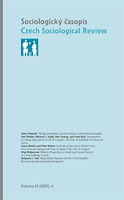‘Margin Insensitivity’ and the Analysis of Educational Inequality
‘Margin Insensitivity’ and the Analysis of Educational Inequality
Author(s): Ottar HellevikSubject(s): Social Sciences
Published by: AV ČR - Akademie věd České republiky - Sociologický ústav
Keywords: social inequality; inequality of educational attainment; loglinear measures; measures of inequality; margin insensitivity
Summary/Abstract: A problem in educational attainment research is that measures of association, and not measures of inequality, have been used to observe inequality in the distribution of higher education between classes. While the statistical association between class and education in many countries has been relatively stable, measures of inequality applied to the same data show a marked reduction of inequality in the distribution of higher education over time. This is a result of reduced bias in the allocation mechanisms, most likely facilitated by the increasing provision of higher education. Decreasing inequality means that the conclusion in the literature that egalitarian educational reforms have been ineffective lacks empirical support. One reason why measures of inequality have been overlooked in most educational attainment research may be the fi rm but unfounded belief in the ‘margin insensitivity’ of loglinear measures. They are assumed to capture the association net of changes in the marginals of the class-by-education table, thus refl ecting the ‘true nature’ of the allocation mechanism in recruitment to higher education. This notion can be shown to be a logically untenable deduction from the property of loglinear measures of being insensitive in relation to one specific kind of change in the marginals, to the claim that these measures are insensitive to marginal changes in general.
Journal: Sociologický časopis / Czech Sociological Review
- Issue Year: 43/2007
- Issue No: 06
- Page Range: 1095-1119
- Page Count: 25
- Language: English

